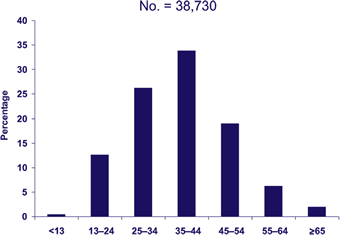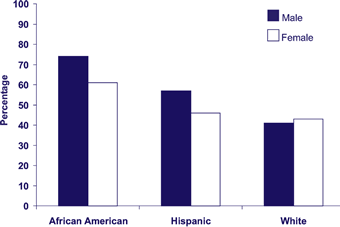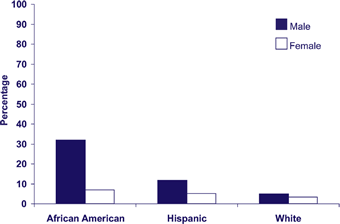|
Young people in the United States are at persistent risk for HIV infection. This risk is especially notable for youth of minority races and ethnicities. Continual HIV prevention outreach and education efforts, including programs on abstinence and on delaying the initiation of sex, are required as new generations replace the generations that benefited from earlier prevention strategies. Unless otherwise noted, this fact sheet defines youth, or young people, as persons who are 13–24 years of age.
STATISTICS
HIV/AIDS in 2004
The following are based on data from the 35 areas with long-term, confidential name-based HIV reporting.*
- An estimated 4,883 young people received a diagnosis of HIV infection or AIDS, representing about 13% of the persons given a diagnosis during that year [1].
- HIV infection progressed to AIDS more slowly among young people than among all persons with a diagnosis of HIV infection. The following are the proportions of persons in whom HIV infection did not progress to AIDS within 12 months after diagnosis of HIV infection:
- 81% of persons aged 15–24
- 70% of persons aged 13–14
- 61% of all persons
- African Americans were disproportionately affected by HIV infection, accounting for 55% of all HIV infections reported among persons aged 13–24
[2].
- Young men who have sex with men (MSM), especially those of minority races or ethnicities, were at high risk for HIV infection. In the 7 cities that participated in CDC’s Young Men’s Survey during 1994–1998, 14% of African American MSM and 7% of Hispanic MSM aged 15–22 were infected with HIV
[3].
- During 2001–2004, in the 33 states with long-term, confidential name-based HIV reporting, 62% of the 17,824 persons 13–24 years of age given a diagnoses of HIV/AIDS were males, and 38% were females.
Age of persons with HIV infection or AIDS diagnosed during 2004

Note. Based on data from 35 areas with long-term, confidential name-based HIV reporting.
AIDS in 2004
- An estimated 2,174 young people received a diagnosis of AIDS (5.1% of the estimated total
of 42,514 AIDS diagnoses), and 232 young people with AIDS died [1].
- An estimated 7,761 young people were living with AIDS, a 42% increase since 2000, when 5,457 young people were living with AIDS [1].
- Young people for whom AIDS was diagnosed during 1996–2004 lived longer than persons with AIDS in any other age group except those younger than 13 years. Nine years after receiving a diagnosis of AIDS, 76% of those aged 13–24 were alive, compared with
- 81% of those younger than age 13
- 74% of those aged 25–34
- 70% of those aged 35–44
- 63% of those aged 45–54
- 53% of those aged 55 and older [1].
- Since the beginning of the epidemic, an estimated 40,059 young people in the United States had received a diagnosis of AIDS, and an estimated 10,129 young people with AIDS had died. They accounted for about 4% of the estimated total of 944,306 AIDS diagnoses and 2% of the 529,113 deaths of people with AIDS [1].
RISK FACTORS AND BARRIERS TO PREVENTION
Sexual Risk Factors Early age at sexual initiation. According to CDC’s Youth Risk Behavioral Survey (YRBS), many young people begin having sexual intercourse at early ages: 47% of high school students have had sexual intercourse, and 7.4% of them reported first sexual intercourse before age 13 [4]. HIV/AIDS education needs to take place at correspondingly young ages, before young people engage in sexual behaviors that put them at risk for HIV infection.
High school students reporting ever having had sexual intercourse, 2003

Source. CDC’s Youth Risk Behavioral Survey, 2003 [4].
High school students reporting sexual intercourse for the first time before age 13, 2003

Source. CDC’s Youth Risk Behavioral Survey, 2003 [4].
Heterosexual transmission. Young women, especially those of minority races or ethnicities, are increasingly at risk for HIV infection through heterosexual contact. According to data from a CDC study of HIV prevalence among disadvantaged youth during the early to mid-1990s, the rate of HIV prevalence among young women aged 16–21 was 50% higher than the rate among young men in that age group [5]. African American women in this study were 7 times as likely as white women and 8 times as likely as Hispanic women to be HIV-positive. Young women are at risk for sexually transmitted HIV for several reasons, including biologic vulnerability, lack of recognition of their partners’ risk factors, inequality in relationships, and having sex with older men who are more likely to be infected with HIV.
MSM. Young MSM are at high risk for HIV infection, but their risk factors and the prevention barriers they face differ from those of persons who become infected through heterosexual contact. According to a CDC study of 5,589 MSM, 55% of young men (aged 15–22) did not let other people know they were sexually attracted to men [6]. MSM who do not disclose their sexual orientation are less likely to seek HIV testing, so if they become infected, they are less likely to know it. Further, because MSM who do not disclose their sexual orientation are likely to have 1 or more female sex partners, MSM who become infected may transmit the virus to women as well as to men. In a small study of African American MSM college students and nonstudents in North Carolina, the participants had sexual risk factors for HIV infection, and 20% had a female sex partner during the preceding 12 months [7].
Sexually transmitted diseases (STDs).
The presence of an STD greatly increases a person’s likelihood of acquiring or transmitting HIV [8]. Some of the highest STD rates in the country are those among young people, especially young people of minority races and ethnicities [9].
Substance Abuse
Young people in the United States use alcohol, tobacco, and other drugs at high rates [10]. Both casual and chronic substance users are more likely to engage in high-risk behaviors, such as unprotected sex, when they are under the influence of drugs or alcohol [11]. Runaways and other homeless young people are at high risk for HIV infection if they are exchanging sex for drugs or money.
Lack of Awareness
Research has shown that a large proportion of young people are not concerned about becoming infected with HIV [12]. Adolescents need accurate, age-appropriate information about HIV infection and AIDS, including how to talk with their parents or other trusted adults about HIV and AIDS, how to reduce or eliminate risk factors, how to talk with a potential partner about risk factors, where to get tested for HIV, how to use a condom correctly. Information should also include the concept that abstinence is the only 100% effective way to avoid infection.
Poverty and Out-of-School Youth
Nearly 1 in 4 African Americans and 1 in 5 Hispanics live in poverty [13]. The socioeconomic problems associated with poverty, including lack of access to high-quality health care, can directly or indirectly increase the risk for HIV infection [14]. Young people who have dropped out of school are more likely to become sexually active at younger ages and to fail to use contraception [15].
The Coming of Age of HIV-Positive Children
Many young people who contracted HIV through perinatal transmission are facing decisions about becoming sexually active. They will require ongoing counseling and prevention education to ensure that they do not transmit HIV.
PREVENTION
CDC estimates
that 56,300 new HIV infections occurred in the United States in 2006 [16]. Populations of minority races or ethnicities are disproportionately affected by the HIV epidemic. To reduce further the incidence of HIV, CDC announced a new initiative, Advancing HIV Prevention, in 2003. This initiative comprises 4 strategies: making HIV testing a routine part of medical care, implementing new models for diagnosing HIV infections outside medical settings, preventing new infections by working with HIV-infected persons and their partners, and further decreasing perinatal HIV transmission.
Through the Minority AIDS Initiative,
CDC explores ways to reduce health disparities in communities made up of persons of minority races or ethnicities who are at high risk for HIV. These funds are used to address the high-priority HIV prevention needs in such communities.
CDC provides 9 awards to community-based organizations (CBOs) that focus primarily on youth and provides indirect funding through state, territorial, and local health departments to organizations serving youth. Of these 9 awards, 5 are focused on African Americans, 3 on Hispanics, 1 on Asians and Pacific Islanders, and 1 on whites. The following are some CDC-tested prevention programs that state and local health departments and CBOs can provide for youth.
- Teens Linked to Care is focused on young people aged 13–29 who
are living with HIV.
- Street Smart is an HIV/AIDS and STD prevention program for runaway and homeless youth.
- PROMISE (Peers Reaching Out and Modeling Intervention Strategies for
HIV/AIDS Risk Reduction in their Community) is a community-level HIV prevention intervention that relies on role-model stories and peers from the community.
- Adult Identity Mentoring project, which encourages students to articulate personal goals and then teaches them the skills required to achieve those goals, can be effective in helping at-risk youth delay the initiation of sex [17].
CDC research has shown that early, clear parent-child communication regarding values and expectations about sex is an important step in helping adolescents delay sexual initiation and make responsible decisions about sexual behaviors later in life. Parents are in a unique position to engage their children in conversations about HIV, STD, and teen pregnancy prevention because the conversations can be ongoing and timely [18].
Schools also can be important partners for reaching youth before high-risk behaviors are established, as evidenced by the YRBS finding that 88% of high school students in the United States reported having been taught about AIDS or HIV infection in school.
Overall, a multifaceted approach to HIV/AIDS prevention, which includes individual, peer, familial, school, church, and community programs, is necessary to reduce the incidence of HIV/AIDS in young people. For Guidelines for Effective School Health Education to Prevent the Spread of AIDS, visit
http://www.cdc.gov/
HealthyYouth/sexualbehaviors/guidelines/guidelines.htm.
Understanding HIV and AIDS Data
AIDS
surveillance: Through a uniform system, CDC receives reports of AIDS cases from all US states and dependent areas. Since the beginning of the epidemic, these data have been used to monitor trends because they are representative of all areas. The data are statistically adjusted for reporting delays and for the redistribution of cases initially reported without risk factors. As treatment
has become more available, trends in new AIDS diagnoses no longer accurately represent trends in new HIV infections; these data now represent persons who are tested late in the course of HIV infection, who have limited access to care, or in whom treatment has failed.
HIV surveillance: Monitoring trends in the HIV
epidemic today requires collecting information on HIV cases that have
not progressed to AIDS. Areas with confidential name-based HIV infection reporting requirements
use the same uniform system for data collection
on HIV cases as for AIDS cases. A total of 33 states
(Alabama, Alaska, Arizona, Arkansas, Colorado, Florida,
Idaho, Indiana, Iowa, Kansas, Louisiana, Michigan,
Minnesota, Mississippi, Missouri, Nebraska, Nevada,
New Jersey, New Mexico, New York, North Carolina,
North Dakota, Ohio, Oklahoma, South Carolina,
South Dakota, Tennessee, Texas, Utah, Virginia, West
Virginia, Wisconsin, and Wyoming) have collected
these data for at least 5 years, providing sufficient data
to monitor HIV trends and to estimate risk behaviors for
HIV infection.
HIV/AIDS: This term is used to refer to 3 categories of diagnoses collectively: (1) a diagnosis of HIV infection (not AIDS), (2) a diagnosis of HIV infection and a later diagnosis of AIDS,
and (3) concurrent diagnoses of HIV infection and AIDS. |
REFERENCES
-
CDC HIV/AIDS Surveillance Report, 2004. Vol. 16. Atlanta: US Department of Health and Human Services, CDC: 2005:1–46.
-
CDC. HIV Prevention in the Third Decade.
Atlanta: US Department of Health and Human Services, CDC; 2005.
- CDC.
HIV incidence among young men who have sex with men—seven US cities, 1994–2000.
MMWR 2001;50:440–444.
- CDC.
Youth Risk Behavior Surveillance―United States, 2003.
MMWR 2004;53(SS-2):1–29.
- Valleroy LA, MacKellar DA, Karon JM, Janssen RS, Hayman DR. HIV infection in disadvantaged out-of-school youth: prevalence for U.S. Job Corps entrants, 1990 through 1996.
Journal of Acquired Immune Deficiency Syndromes 1998;19:67–73.
- CDC.
HIV/STD risks in young men who have sex with men who do not disclose their sexual orientation—six US cities, 1994–2000.
MMWR 2003;52:81–85.
- CDC.
HIV transmission among black college student and non-student men who have sex with men―North Carolina, 2003.
MMWR 2004;53:731–734.
- Fleming DT, Wasserheit JN. From epidemiological synergy to public health policy and practice: the contribution of other sexually transmitted diseases to sexual transmission of HIV infection.
Sexually Transmitted Infections 1999;75:3–17.
- CDC.
Sexually Transmitted Disease Surveillance, 2004.
Atlanta: US Department of Health and Human Services, CDC; 2005.
- Substance Abuse and Mental Health Services Administration.
2004 National Survey on Drug Use & Health.
- Leigh BC, Stall R. Substance use and risky sexual behavior for exposure to HIV: issues in methodology, interpretation, and prevention.
American Psychologist 1993;48:1035–1045.
- The Kaiser Family Foundation.
National Survey of Teens on HIV/AIDS, 2000.
- US Census Bureau.
Poverty: 1999. Census 2000 Brief. May 2003.

- Diaz T, Chu SY, Buehler JW, et al. Socioeconomic differences among people with AIDS: results from a multistate surveillance project.
American Journal of Preventive Medicine 1994;10:217–222.
- Office of the Surgeon General.
The Surgeon General’s call to action to promote sexual health and
responsible sexual behavior, July 9, 2001.
- Hall HI, Ruiguang S, Rhodes P, et al. Estimation of HIV incidence in the United States.
JAMA. 2008;300:520-529.
- Clark LF, Miller KS, Nagy SS, et al. Adult identity mentoring: reducing sexual risk for African-American seventh grade students.
Journal of Adolescent Health 2005;37:337.e1–337.e10.
- Dittus P, Miller KS, Kotchick BA, Forehand R. Why Parents Matter!: the conceptual basis for a community-based HIV prevention program for the parents of African American youth.
Journal of Child and Family Studies 2004;13(1):5–20.
|